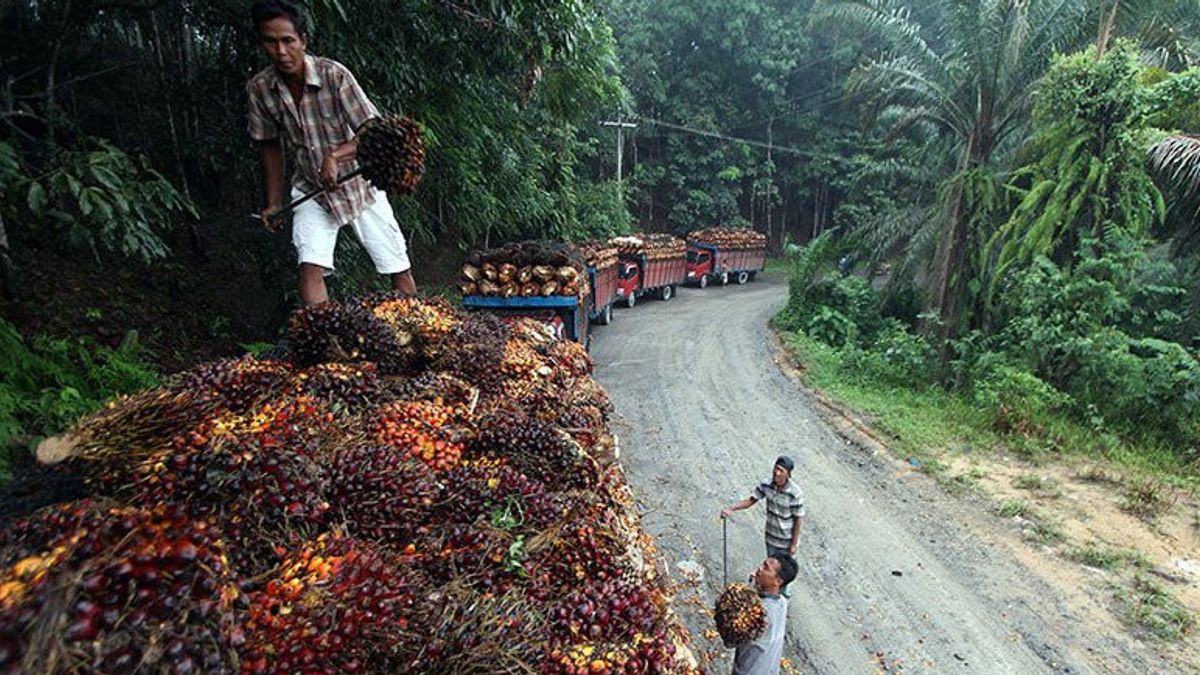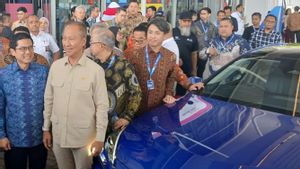JAKARTA - Palm oil contributes greater employment than other commodities. The potential for employment by the palm oil industry is still wide open, especially from the downstream side.
Secretary General of the Indonesian Palm Oil Entrepreneurs Association (GAPKI) Eddy Martono explained that employment is divided widely from upstream to downstream. On the upstream side, 59 percent of this sector is managed by the company and the remaining 41 percent is managed by the community.
Although the economic sector is currently overshadowed by inflation and crisis, the potential for employment in this industry is still quite large.
"In addition, in the upstream oil palm sector, full mechanization cannot be carried out, so there is still a lot of need for manpower," he said in Jakarta, Friday, November 4.
He estimates that the total employment absorption reaches around 5 million people spread across various palm oil centers. The total plantation area reaches 16.3 million hectares.
Eddy admits that for the upstream sector, labor absorption will not continue to increase as long as there is no plantation development. According to him, the increase in labor is likely to occur in the downstream sector.
"But if there is continued development in the downstream sector, it is likely that it will increase downstream," he added.
Although he does not have a great opportunity to increase, Eddy assesses that the workforce in the upstream sector has a much more crucial role in the sustainability of the palm oil industry. If there are obstacles upstream, the entire process will also be hampered.
Apart from the upstream and downstream sectors, the workforce in the palm oil industry is also divided into direct workers, namely workers in palm oil factories, as well as supporting workers, starting from land or sea transportation.
"For the future, the increasing workforce is only in the downstream sector because upstream there is a practically no garden expansion moratorium," said Eddy.
Previously, Bappenas in 2018 mentioned that the palm oil industry was able to absorb 16.2 million workers with details of 4.2 million direct workers and 12 million indirect workers.
It is estimated that it will increase
Employment observer from Gadjah Mada University (UGM), Tadjudin Nur Effendi assesses that the absorption of Indonesian palm oil workers still has the potential to increase.
"The figure is big because the majority in North Sumatra, Riau, then in several places in Kalimantan, oil palm plantations are quite large," Tadjudin said by telephone, on different occasions.
In fact, according to Tadjudin, the total of 16 million is still not optimal. He estimates that the absorption of Indonesian palm oil workers can reach 20 to 25 million workers. "In some areas, it is still difficult to find oil palm workers," he added.
In line with Tadjudin, Researcher from the Institute for Development of Economics and Finance (Indef), Nailul Huda projects that in the future demand for palm workers can still increase rapidly.
"The official data states that there are around 2.7 million farmers and 4.4 million workers in the oil palm plantation sector. The data is in 2019/2020. Of course, the number could increase considering that usually the demand for workers will increase rapidly when the price of palm oil increases," said Huda, Friday.
One example of an oil palm company that absorbs a large number of workers is Wilmar. The large number of workers because the company is moving from upstream and downstream. For Plantation alone, Wilmar is recorded to have absorbed more than 11 thousand employees. Meanwhile, employees for downstream reach more than 31 thousand people. When coupled with a multiplier-effect impact, it is estimated that it will reach two to three times.
With the current price relatively high, Huda is optimistic that there will still be niche for oil palm workers. Moreover, the characteristics of palm oil workers are not educated workers, so it is not too difficult to find available workers.
Tadjudin explained the relationship between the price of FFB and the absorption of palm oil. According to him, if the price of FFB is good, then the absorption of palm oil is high because entrepreneurs or planters need to harvest palm oil quickly. Panening must be done every two weeks.
"When the price of FFB is Rp1,000 per kg, people don't want to harvest palm oil, it means low absorption of their workforce. The uncertain price of palm oil in the international world is ups and downs and downs, it causes absorption of their workforce to also go ups and downs, not continuously or sustainably. So it depends on the price of FFB," explained Tadjudin.
Meanwhile, at the time of the FFB price of Rp. 3,500 per kg, for example, the absorption of the workforce will be large and could be short of manpower, especially for the harvest season.
"Even young people in rural areas around palm oil do not want to look for work outside because the wages are high. They work 2-3 hours and they can get Rp200-300 thousand. Coincidentally, I did research in 2015 in factories around North Sumatra. They complained that many workers asked to stop and return to their respective areas because the wages in oil palm plantations were high," concluded Tadjudin.
The English, Chinese, Japanese, Arabic, and French versions are automatically generated by the AI. So there may still be inaccuracies in translating, please always see Indonesian as our main language. (system supported by DigitalSiber.id)
Most Popular Tags
#Prabowo Subianto #golkar #Pilkada Dki #online gambling #Mount Lewotobi malePopular
22 November 2024, 06:10
22 November 2024, 07:07
22 November 2024, 09:05













